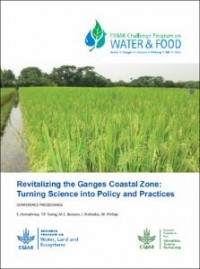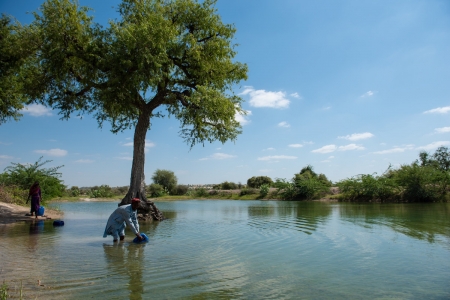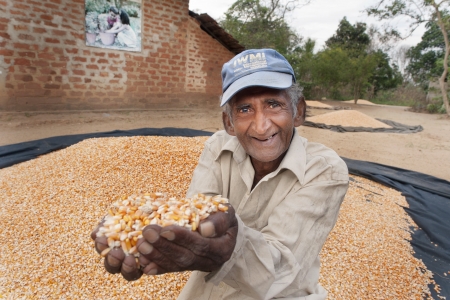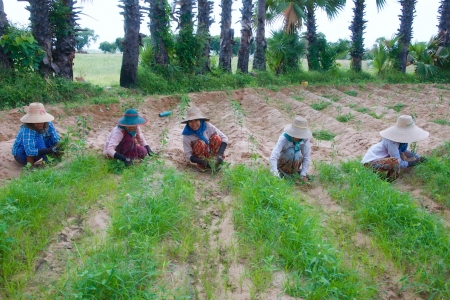The coastal zone of the Ganges River encompasses parts of West Bengal, India and Bangladesh. Poverty in the region, particularly amongst farming communities, remains extreme despite more than 50 years of investment. Improving food security and livelihoods in the coastal zone is possible. And one CGIAR Research Program on Water, Land and Ecosystems (WLE) project is seeking to demonstrate that such improvements are possible with existing advances in crop and aquaculture technologies and available water resources. The project builds on work conducted under the CGIAR Challenge Program on Water and Food (CPWF) from 2003 to 2014, which culminated in a conference entitled ‘Revitalizing the Ganges Coastal Zone: Turning Science into Policy and Practice’.
Interview with Liz Humphreys
 WLE sat down with Liz Humphreys, former International Rice Research Institute researcher and CPWF project leader, to discuss the conference and its newly published proceedings, as well as the status of ongoing WLE work in the region.
WLE sat down with Liz Humphreys, former International Rice Research Institute researcher and CPWF project leader, to discuss the conference and its newly published proceedings, as well as the status of ongoing WLE work in the region.
Can you explain the concept behind the Revitalizing the Ganges Coastal Zone conference? What were the goals?
The concept was to bring together researchers, development project personnel, donors and policy makers to share plans, progress and ideas for unlocking the potential of the Ganges coastal zone. In particular, we wanted to share the insights, findings, and recommendations of the CPWF Ganges projects conducted over the past 10 years. One of our goals was to use the conference as part of our ongoing effort to influence policy and investment in the coastal zone.
Despite the huge investment in the coastal zone over the past 50 years, the poverty of farming families in the region remains extreme. Land and water productivity is very low, and agricultural practices have not changed in the last 50 years, unlike the rest of Bangladesh, which has surged ahead. Yet our work shows that, with existing advances in crop and aquaculture technologies and existing water resources, there are tremendous opportunities to increase productivity and improve food security and livelihoods in the coastal zone.
What happened during the conference?
Around 200 participants attended day 1, which focused on how the Government of Bangladesh (GoB), policy makers, donors and development projects are working to improve coastal water resources management and development. Participants included top-level officials from the Ministries of Water Resources and Fisheries and Agriculture. A common message was the need for cross-sector collaboration, which is currently badly lacking.
Another common theme was the value of research in contributing to policy making and government programs. We also received updates from a range of mega development projects, and from donors with programs in the coastal zone. They had been asked to review the CPWF Ganges messages document and discuss their relevance to their programs. We received strong affirmation of the relevance of our findings and recommendations, and believe that we are achieving small inroads of influence.
The second and third days were devoted to sharing and debating the findings and recommendations of recent research, with about 41 oral and 15 poster presentations. The interest and enthusiasm of the 100+ participants at the science conference was remarkable and thrilling. I have never before experienced such a vibrant conference atmosphere, with all seats filled to the last word of the conference at the end of the third day. I doubt that there has ever been such a Ganges coastal zone conference covering such a breadth of topics, from water resources and governance to aquaculture, homestead and agricultural production systems, from environment and biodiversity to methodologies and tools for targeting improved cropping systems across the landscape. I think that’s why people enjoyed it so much—they got to see the whole picture.

Why a scientific proceedings?
Well, the original driver was that it would be beneficial for the careers of our many young national scientists working on CPWF projects to have their work published in a book with an ISBN. However, having gone through the process of producing the proceedings, I believe we have done something far, far more valuable than that.
These proceedings are a unique, up-to-date and comprehensive account of our understanding of the current status of water resources, and of opportunities for increasing productivity and improving the livelihoods of the millions of poor rural families of the Ganges coastal zone. The papers are readily accessible online. All the papers were reviewed by experts, who also worked with the authors to ensure that there was good rigor in the published work. This process was also extremely beneficial for the development of the analytical and writing skills of many of the national scientists. So, with the benefit of hindsight, there were many reasons for producing a science proceedings.

Revitalizing the Ganges coastal zone: turning science into policy and practices
The proceedings is a big document (more than 40 papers, 500 pages). What are some of the themes that emerge?
Yeah, it’s huge. I’m glad I didn’t know how big it was going to be before we started! Some of the main themes to emerge at the conference, and now documented in the proceedings, include the facts that, contrary to the belief of many, the coastal zone is rich in water resources, and these water resources are vastly underutilized. There is huge potential for greatly increasing agricultural and aquacultural productivity through cropping system intensification and diversification. However, achieving this requires investment in water management infrastructure inside the polders (as well as on the periphery) with special emphasis on drainage, and on community water management and coordination of production systems within the catchment area of each sluice gate.
Maintenance of infrastructure is the Achilles heel of water management in the polders of the coastal zone, and is often deferred due to lack of incentives and funds. Changes are needed in methods for the generation of funds for maintenance, and in water governance frameworks to enable improved water management. Enhancing trans-boundary cooperation on water is vital for future agricultural and aquacultural production—to ensure adequate trans-boundary flow during the dry season and to mitigate the adverse effects of climate change and sea level rise on salinity intrusion during the dry season and on inundation during rainy season. Access to data and modern tools in planning, policy analysis, technology targeting and consensus building are needed.
Who do you hope will make use of this document?
I think that the proceedings are a very valuable educational tool, and I hope that university teachers and students will be major users, along with researchers and extensionists. In addition to making the proceedings available online, we will be distributing many hard copies to university and research institute libraries in Bangladesh. Many of the papers should also be of interest to donors and policy makers formulating plans for investment in development of the coastal zone.
CPWF has ended but some of the program’s work is being built upon through WLE. Can you discuss the project you are working on as part of WLE’s work in the Ganges?
We have started a new project “Community water management for improved food security, nutrition and livelihoods in the polders of the coastal zone of Bangladesh”, under the leadership of Dr Manoranjan Mondal of the International Rice Research Institute. This project builds on ideas, data, technologies and partnerships developed during CPWF, in combination with a new partner, the Blue Gold development program. It is the acid test of our belief that the production potential of the polders can be more than doubled through improved community water management. The biophysical part is relatively straight forward – excavation of silted up drains, separation of lands of higher and lower elevation with small levees, installation of small field drains, systematic operation of the sluice gates to drain excess water, introduction of improved rice and upland varieties, and so on. The real challenge is the achievement of a shared community vision and community co-ordination in order to realise the dream. If Manoranjan and team can pull this one off with the community, I think that we will be opening the door to a new chapter in the development of the coastal zone.






